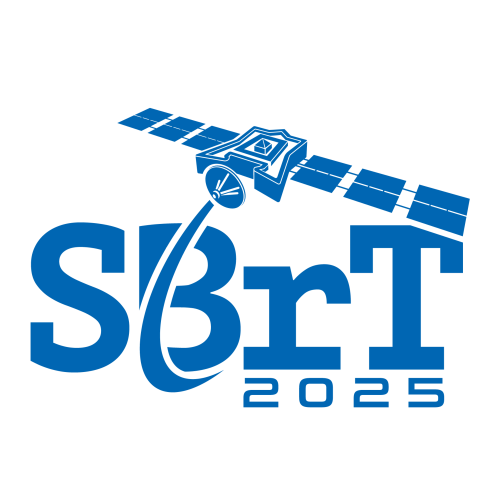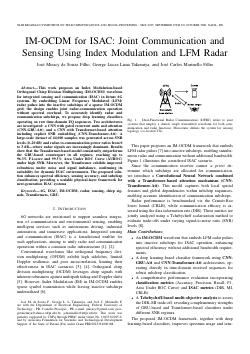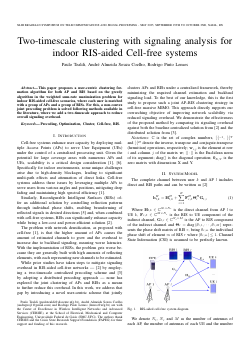
XLIII Simpósio Brasileiro de Telecomunicações e Processamento de Sinais

Arithmetic Reconciliation for CVQKD Protocols
Ravilla Leite, Juliana Martins de Assis, Francisco M. Assis
DOI: 10.14209/sbrt.2025.1571157285
Keywords: Reconciliation CVQKD Cryptography Distributional Transform
Abstract
Quantum key distribution allows the distribution of a secret key with applications to cryptography. Specially, continuous variable quantum key distribution presents some advantages over its discrete counterpart and involves a reconciliation protocol where the continuous variable must be transformed to a binary sequence common to both trusted parties. Recently proposed arithmetic reconciliation is one of the possible scheme. In this paper, we evaluate the performance of this scheme both mathematically and through simulations, as also achieve expressions and simulations for the obtained reconciliation efficiencies. These results suggest that arithmetic reconciliation is a promising technique in continuous variable quantum key distribution.Download

Inter-symbol and Multi-user Interference Cancellation for LEO Satellite Systems
Felipe F Souto, Victor Fernandes, Alberto G. Guimarães, Vinicius Nunes Henrique Silva, Roberto B. Di Renna
DOI: 10.14209/sbrt.2025.1571157286
Keywords: OTFS detection interference cancellation. LEO satellite channel
Abstract
The orthogonal time frequency space (OTFS) scheme has been considered a promising technique to deal with high Doppler scenarios, where inter-user and inter-symbol interference are significant. Studying the low Earth orbit (LEO) satellite systems, in this work we propose a DD multi-feedback successive interference cancellation (DD-MF-SIC) detector with shadow area constraints (SAC) to enhance symbol reliability and mitigate error propagation. A multi-user uplink scenario is considered, where users transmit over independent sparse delay--Doppler channels and the classical block linear minimum mean square error (BLMMSE) detector is used as a baseline. Simulation results show that the proposed approach yields relevant bit error rate (BER) gains under relevant Doppler conditions, with a competitive computational cost.Download

GVNF-P: An Energy-Aware Genetic Algorithm for VNF Placement in B5G Networks
Matheus Gabriel Pantoja, Albert E. C. Santos, Reyso Cunha Teixeira, Rafael Fogarolli Vieira, Diego L Cardoso
DOI: 10.14209/sbrt.2025.1571157289
Keywords: Energy efficiency B5G networks NFV VNF placement
Abstract
This paper presents GVNF-P, a genetic-algorithm framework that minimises energy consumption while placing Virtual Network Functions (VNFs) for service function chains in beyond-5G (B5G) cloud networks. The algorithm encodes SFC order within chromosomes, leverages a server-centred power model that separates static and dynamic costs, and employs problem-aware crossover and mutation operators to guide the search through feasible solutions. Experiments on heterogeneous B5G topologies show that GVNF-P achieves energy savings within 3% of an integer linear programming optimum while reducing computation time by more than an order of magnitude-dropping from 4.5 minutes to just 0.12 minutes-and keeping memory usage low under realistic traffic and resource load conditions.Download

Automatic detection and classification of Brazilian traffic signs using YOLO
Carlos Henrique Anselmo Tavares, Gabriel Marinho de Oliveira, Ana Cecília Costa Martins, Yan Souza Moura, Tarcisio Ferreira-Maciel
DOI: 10.14209/sbrt.2025.1571157293
Keywords: Traffic signs detection classification YOLO
Abstract
Poor traffic sign conditions compromise road safety and due to the huge dimensions of the road network, its manual inspection is an expensive and time consuming task. This work demonstrates the use of the YOLO (You Look Only Once) algorithm for automated detection and classification of Brazilian traffic signs. An initial model was trained on a small dataset of manually analyzed images. The trained model was then used to process a larger set of images extracted from public videos and from the Internet. The resulting enlarged dataset was subjected to manual verification and correction of the initial detections/classifications, generating a final dataset with over 2,000 images (over 6,000 after data augmentation). A final model was then trained on the refined dataset, achieving significant accuracy, recall, and mAP@50 values for the 10 most well represented traffic signs. The simple approach presented herein shows a strong potential for cost-effective, real-world applications in intelligent traffic systems and urban monitoring.Download

IM-OCDM for ISAC: Joint Communication and Sensing Using Index Modulation and LFM Radar
Jose Miracy de Souza Fo, George Lucas Lima Takemiya, José Carlos Marinello
DOI: 10.14209/sbrt.2025.1571157297
Keywords: ISAC Transformers GRU IM_OCDM
Abstract
This paper presents an Index Modulation-enabled Orthogonal Chirp Division Multiplexing (IM-OCDM) waveform tailored for integrated sensing and communication (ISAC) in future 6G networks. The proposed approach leverages inactive subchirps to transmit Linear Frequency Modulated (LFM) radar signals, enabling dual functionality without requiring additional bandwidth. A Convolutional Neural Network combined with a Transformer-based attention mechanism is employed to accurately separate radar and communication components. This architecture effectively captures both local spatial features and global dependencies within the signal. Compared to conventional recurrent models such as \textbf{CNN-GRU-Attention}, the Transformer-based model demonstrates superior robustness under low-SNR conditions, achieving up to 100\% accuracy and F1-score at SNR levels of -5~dB and 0~dB. Meanwhile, the CNN-GRU-Attention baseline achieves peak F1-scores of 98.2\% under favorable SNR conditions but exhibits greater sensitivity in noisy environments. Simulation results confirm significant improvements in classification accuracy, spectrum efficiency, and radar sensing quality. This unified waveform design addresses key challenges in 6G ISAC systems and offers a scalable, efficient solution for complex signal processing tasks.Download

User-Centric Clustering in Cell-Free Networks with Dynamic TDD
Samuel S Silva, Yuri C. B. Silva, Igor M. Guerreiro, Victor Farias Monteiro, Matheus D. Carneiro, Abraão de Carvalho Albuquerque
DOI: 10.14209/sbrt.2025.1571157298
Keywords: Cell-Free system MIMO D-TDD
Abstract
This work investigates the performance of a cell-free multiple-input multiple-output (MIMO) system with dynamic time division duplex (D-TDD), in which user-centric clustering algorithms are introduced as an additional stage to dynamically allocate access points (APs) at each time slot. This additional step enables an AP to simultaneously serve multiple user equipment (UEs) transmitting in the same direction. The implementation of these algorithms, incorporating an additional clustering step, is motivated by the fact that assigning an AP to serve multiple UEs does not significantly increase the system's interference levels; however, it can enhance the signal strength received from or by a given UE. The results indicate an advantage in applying an additional clustering step-or, conversely, a disadvantage in maintaining disjoint clusters of UEs transmitting in the same direction. This additional step yields greater performance improvements for uplink (UL) transmissions. This outcome can be explained by the fact that, when an AP is allocated to serve multiple UEs, the resulting increase in interference levels for downlink (DL) UEs is not substantial compared to the gain in received signal strength. In contrast, for UL transmissions, no additional interference is introduced, while the received signal strength increases significantly due to the larger number of antennas available to serve each UE.Download

Two-timescale clustering with signaling analysis for indoor RIS-aided Cell-free systems
Paulo Tealdi, André Almeida Souza Coelho, Rodrigo P Lemos
DOI: 10.14209/sbrt.2025.1571157299
Keywords:
Abstract
This paper aims to provide a simple greedy solution for a user-centric clustering scheme in the joint precoding problem for indoor RIS-aided cell-free scenarios, where each user is matched with a group of APs and a group of RISs. For this, a non-convex joint precoding problem is solved following methods available in the literature, where we add a two-timescale approach for clustering formation and investigate its impacts on signaling overhead.Download

Amostragem em redes de difusão adaptativas na presença de ruído impulsivo
Vitor H Duque, Daniel Tiglea, Magno T M Silva
DOI: 10.14209/sbrt.2025.1571157300
Keywords: redes de difusão adaptativas amostragem ruído impulsivo critério da máxima correntropia
Abstract
Neste artigo é proposto um algoritmo de amostragem para redes de difusão adaptativas em ambientes com ruído impulsivo. Baseado no critério da máxima correntropia (maximum correntropy criterion -- MCC), o algoritmo proposto busca manter os nós amostrados quando o MCC é baixo e deixa de amostrá-los caso contrário, reduzindo significativamente o custo computacional e de memória associados à aprendizagem. As simulações mostram que a solução proposta é mais robusta a ruído impulsivo que algoritmos existentes na literatura em diferentes cenários.Download

DoS Attack Detection in 5G Core Network using Machine Learning
Abdel Fadyl Chabi, João Vitor da S. Campos, Vivianne de Aquino Rodrigues, Matheus Fontinele de Aguiar
DOI: 10.14209/sbrt.2025.1571157302
Keywords: 5G networks Security DoS attack Machine learning
Abstract
Contrary to previous mobile networks, 5G architecture is service based and utilize Network Functions (NFs) to manage connectivity, security, data management, and other functionalities of the network. This kind of architecture allow 5G networks to be more scalable, flexible and eficient than the legacy networks, however, service based networks also introduces a series of vulnerabilities. As 5G networks evolve, security becomes as much of a concern as network performance. 5G networks allow the introduction of machine learning techniques, which can improve network performance, as well as ensure security through the implementation of machine learning models on both base station and User Equipment (UE) side. In this paper we use five machine learning algorithm, namely Random Forest, XGboost, Decision Tree, Multi-Layer Perceptron (MLP) and LightGBM to detect Denial of Service (DoS) attack in 5G core network. Friedmann and Nemenyi tests have been performed to compare the models performance and elect the best model among the five implemented. Random Forest, XGBoost and Decision Tree are elected the best model for Dos attack detection problem, when comparing the metrics and statistical results obtained.Download

Detecção de Vagas de Estacionamento Baseada em Visão Computacional com Mínima Intervenção Humana
Caio de Souza de Medeiros, Rigel Procópio Fernandes
DOI: 10.14209/sbrt.2025.1571157303
Keywords: Detecção de vagas Visão computacional Estacionamentos inteligentes YOLOv8
Abstract
Este trabalho propõe um método de detecção automática da posição de vagas de estacionamento utilizando técnicas de visão computacional, reduzindo a necessidade de intervenção humana para tal. Baseado no modelo YOLOv8 e no agrupamento DBSCAN, avaliamos a capacidade de identificar automaticamente espaços ocupados e livres em imagens reais obtidas do dataset PKLot. O principal objetivo é proporcionar escalabilidade e praticidade na implantação de sistemas de estacionamento inteligente. Resultados preliminares confirmam a viabilidade do método proposto, demonstrando robustez e acurácia satisfatória sob diferentes condições climáticas e de iluminação. O método proposto conseguiu detectar 63,1% das vagas.Download